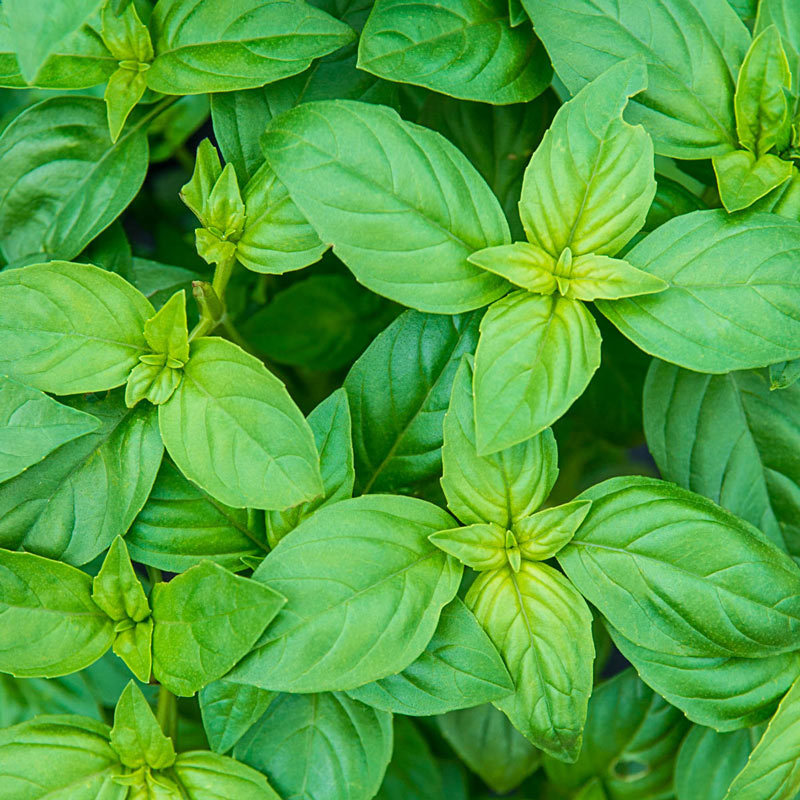Curiosities: In Africa, the leaves have been traditionally used for the treatment of cold, cough, abdominal pain and measle. In addition, the plant is used for its carminative, stimulant, antipyretic, antifungal, antibacterial, insect repellent, and antioxidant properties. The strong camphor scented leaves treat congested chest, cough and cold, by sniffing crushed leaves or inhaling vapour of boiling leaves. Furthermore, popular use of leaves of O. kilimandscharicum (Lamiaceae) against pain as been report.
Basil Organic
Ocimum kilimandscharicum Gürke
ANGOLA
CAS No: 91845-32-8
EINECS No: 295-205-7
Plant Part used: Leaves and flowers. Dry.
Origin: Wild-harvest
Processing: Steam-distillation
Main compounds: Camphor, Limonene
Chemotype: Camphor chemotype [1]
Olfactive experience: Warm and aromatic, spicy-camphoraceous olfactive experience. Strong, medicinal scent.
Compound of the Chromatogram
Relative percentage of each compound of the chromatogram presented BASIL ORGANIC
| Compounds | Relative percentage | Compounds | Relative percentage |
| Tricyclene | 0.2 | Bornyl acetate | t |
| α-Thujene | 0.1 | cis-Methyl cinnamate | 0.3 |
| Benzaldehyde | t | Carvacrol | t |
| α-Pinene | 2.7 | Eugenol | 0.1 |
| Camphene | 5.8 | δ-Elemene | t |
| Sabinene | – | α-Cubebene | – |
| 1-Octen-3-ol | t | trans-Methyl cinnamate | 1.0 |
| 3-Octanone | t | α-Ylangene | t |
| β-Pinene | 0.2 | trans-β-Damascenone | t |
| 3-Octanol | 0.1 | α-Copaene | 1.2 |
| β-Myrcene | 0.9 | β-Bourbonene | 0.5 |
| α-Phellandrene | 0.3 | β-Cubebene | 0.4 |
| δ-3-Carene | t | β-Elemene | 0.7 |
| α-Terpinene | 0.2 | β-Caryophyllene | 1.8 |
| p-Cymene | 0.4 | β-Copaene | 0.2 |
| 1,8-Cineole | t | beta-gurjunene | – |
| Limonene | 9.9 | α-Guaiene* | 4.8 |
| cis-β-Ocimene | t | α-Humulene | 2.7 |
| trans-β-Ocimene | 0.1 | allo-Aromadendrene | 0.1 |
| γ-Terpinene | 0.8 | trans-β-Farnesene | – |
| trans-Sabinene hydrate | 0.5 | γ-Muurolene | t |
| cis-Linalool oxide (furanoid) | t | trans-Cadina-1(6),4-diene | 4.0 |
| Fenchone | 0.4 | Germacrene D | 2.7 |
| 2,5-Dimethyl styrene | t | Valencene | 0.3 |
| Terpinolene | 1.4 | Eremophyllene | – |
| cis-Sabinene hydrate | 0.3 | trans-alpha-bergamotene | – |
| Isopentyl isovalerate | t | cis, trans-α-Farnesene | 1.9 |
| α-Campholenal | t | α-Bulnesene (= δ-Guaiene) | 6.2 |
| Linalool | – | β-Bisabolene | 0.3 |
| Camphor | 43.6 | γ-Cadinene | 0.1 |
| Camphene hydrate* | – | 7-epi-α-Selinene | – |
| Borneol | 0.3 | δ-Cadinene | 0.5 |
| Terpinen-4-ol | 0.5 | Globulol | – |
| Methyl salicylate | – | Grouped components | |
| α-Terpineol | 0.3 | Monoterpene hydrocarbons 23.0% | |
| trans-Piperitol | – | Oxygen-containing monoterpenes 46.1% | |
| trans-Carveol | 0.1 | Sesquiterpene hydrocarbons 28.4% | |
| cis-Carveol | 0.1 | Oxygen-containing sesquiterpenes – 0% | |
| Carvone | t | Phenylpropanoids 0.1% | |
| Others 1.4% | |||
Back to list of essential oils
Scientific Evidence
| Effect | Route used in the experimente | Source |
| No significant toxicity
Against peritoneal macrophages cells |
In-vitro safety evaluation | [3] |
| Antimicrobial activity | Petri dishes – Gram + bacteria (Staphylococcus aureus, Enterococcus faecalis), Gram- bacteria (Escherichia coli, Pseudomonas aeruginosa) and also against yeast Candida albicans. | [4] |
| Wound healing | In vivo/ in vitro screening model
(Significant increase in skin breaking (aqueous extract) strength, granuloma breaking strength, wound contraction, dry granuloma weight and decreased in epithelisation period was observed inanimals of both the treated groups compared to control) |
[5] |
| Insecticidal | In vivo/ in vitro screening model – Sitophilus zeamais and Rhyzopertha dominica | [6] |
| Antioxidant activity
(isolated phenols and essential oil) |
TBARS assay (in vitro) and Enzymatic antioxidant estimation (in vivo) | [7] |
| Antimicrobial activity (isolated compounds) | Broth dilution method | [8] |
| Antibacterial activity | Disc agar diffusion technique | [9] |
| Anti-inflammatory and analgesic/pain-inhibiter (isolated camphor and essential oil) | In vivo screening model – inhibition of carrageenan-induced edema, mechanical and cold hyperalgesia. Both essential oil and isolated camphor from the essential oil inhibited all | [10] |
| Articular parameters induced by zymosan. |
1] Gurav, T.P., Dholakia, B.B. & Giri, A.P. A glance at the chemodiversity of Ocimum species: Trends, implications, and strategies for the quality and yield improvement of essential oil. Phytochem Rev (2021). https://doi.org/10.1007/s11101-021-09767-z.
[2] Roli, A. (2007) Traditional Uses and Pharmacological Action of Ocimum Kilimandscharicum : A Review. JUC Vol. 13(6), 140-144. [3] Chaturvedi, Trishna; Kumar, Ajay; Kumar, Amit; Verma, Ram S.; Padalia, Rajendra C.; Sundaresan, Velusamy; Chauhan, Amit; Saikia, Dharmendra; Singh, Ved R.; Venkatesha, KT (2018). Chemical composition, genetic diversity, antibacterial, antifungal and antioxidant activities of camphor-basil (Ocimum kilimandscharicum Guerke). Industrial Crops and Products, 118(), 246–258. doi:10.1016/j.indcrop.2018.03.050 [4] Prasad, G., Kumar, A., Singh, A.K., Bhattacharya, A.K., Singh, K. and Sharma,- D. (1986). Antimicrobial activity of essential oils of some Ocimum species and clove oil. Fitoterapia; 429–32
. doi:10.1016/j.jep.2020.113697.



